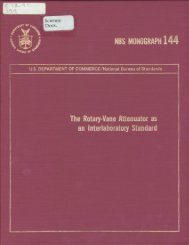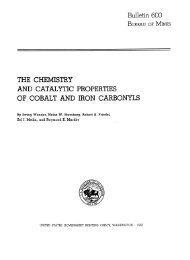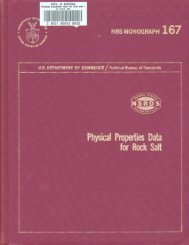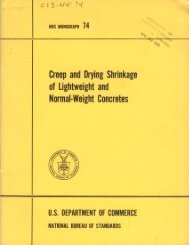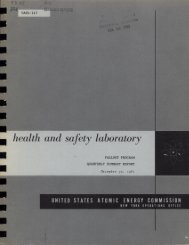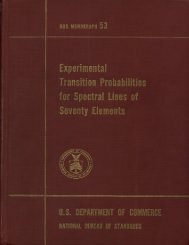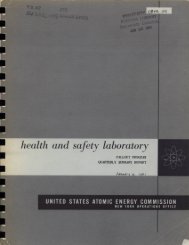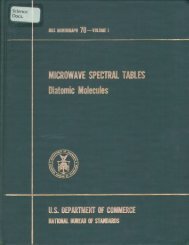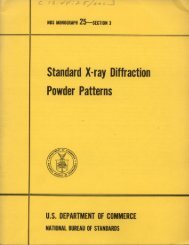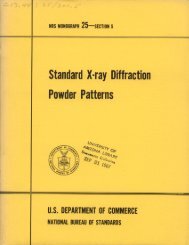Corrosion of Steel Pilings in Soils
Corrosion of Steel Pilings in Soils
Corrosion of Steel Pilings in Soils
- No tags were found...
You also want an ePaper? Increase the reach of your titles
YUMPU automatically turns print PDFs into web optimized ePapers that Google loves.
290.5 to 282.5 : Reddish brown coarse sandta<strong>in</strong><strong>in</strong>g much jsilt and gravel.Elevation293__ ............290.5___. ________288_.____________284___. ____..___.282__ _____ _____282.5 ___________Soil resistivity and pHResistivityOhm-cm8,500 (Shepard Canes). __ _____8,000 (Shepard Canes) ___ _10,000 (Shepard Canes) _ _> 4,000 (Laboratorv) ______10,200 (Laboratory). _ _ ...9,500 (Shepard Canes) __ __ __con-?H5. 15.3Condition <strong>of</strong> piles:Mill scale was <strong>in</strong>tact over more than 90 percent<strong>of</strong> the surface. Slight metal attack was present <strong>in</strong>a few small areas, approximately 1 <strong>in</strong>. <strong>in</strong> diameter.There were no measurable pits.5. DiscussionPrevious <strong>in</strong>vestigations on soil corrosion conductedby the National Bureau <strong>of</strong> Standards have beenrestricted to the behavior <strong>of</strong> metals <strong>in</strong> disturbedsoils; trenches or excavations were dug and backfilled after <strong>in</strong>stallation <strong>of</strong> the specimens. Becauseno prior systematic <strong>in</strong>vestigation perta<strong>in</strong><strong>in</strong>g to thebehavior <strong>of</strong> metals <strong>in</strong> undisturbed soils had beenconducted, it became general practice because noother data were available to apply the <strong>in</strong>formationprovided by the NBS soil <strong>in</strong>vestigations as a guideto estimate the corrosion <strong>of</strong> metals <strong>in</strong> all types <strong>of</strong>underground <strong>in</strong>stallations, under both disturbed andundisturbed soil conditions.The f<strong>in</strong>d<strong>in</strong>gs <strong>of</strong> the National Bureau <strong>of</strong> Standardswith respect to the action <strong>of</strong> soils on metals havebeen presented on numerous occasions <strong>in</strong> variousways, and more recently assembled <strong>in</strong> the NationalBureau <strong>of</strong> Standards Circular 579 [1]. The follow<strong>in</strong>g repetition <strong>of</strong> the previously obta<strong>in</strong>ed major conclusions perta<strong>in</strong><strong>in</strong>g to the corrosion <strong>of</strong> iron and steelis not for the purpose <strong>of</strong> impart<strong>in</strong>g new <strong>in</strong>formation,but to establish a basis for discussion <strong>of</strong> the dataobta<strong>in</strong>ed from the pil<strong>in</strong>g <strong>in</strong>spections.Briefly, the Bureau has found, first, that thecorrosion <strong>of</strong> the commonly used ferrous metals is <strong>of</strong>the same type and order <strong>of</strong> magnitude when exposedto a given soil environment; and second, that thecorrosion <strong>of</strong> ferrous metals <strong>in</strong> different soil environments varies widely. In general, <strong>in</strong> well-dra<strong>in</strong>edhigh-resistivity soils, the rate <strong>of</strong> corrosion may behigh <strong>in</strong>itially, but decreases after a few years toalmost complete cessation <strong>of</strong> pitt<strong>in</strong>g. Conversely,<strong>in</strong> poorly dra<strong>in</strong>ed soils hav<strong>in</strong>g low resistivities, therate <strong>of</strong> corrosion is nearly constant with time afterthe <strong>in</strong>itial period.One <strong>of</strong> the most <strong>in</strong>terest<strong>in</strong>g characteristics <strong>of</strong>underground corrosion is the irregular nature <strong>of</strong> theattack. A section <strong>of</strong> pipe is <strong>of</strong>ten penetrated at onlyone or more po<strong>in</strong>ts and practically no corrosion isfound elsewhere on the section. Usually, the loss<strong>of</strong> ferrous metal is too small to be <strong>of</strong> importance ifit were uniformly distributed over a metal surface.The major cause <strong>of</strong> corrosion can be attributed tothe nonuniformity <strong>in</strong> the distribution <strong>of</strong> oxygen andmoisture along the surface <strong>of</strong> a buried metallicstructure. Variations <strong>in</strong> the supply <strong>of</strong> oxygen canset up oxygen-concentration cells <strong>in</strong> which the metalsurfaces which are least accessible to oxygen areanodic to the surfaces to which oxygen is morereadily accessible. The corrosion may be either general or localized depend<strong>in</strong>g upon the relative size <strong>of</strong>the anodic and cathodic areas. For a given difference<strong>in</strong> potential between the two areas, if the anode areais relatively large compared to the cathode area, thetotal current produced may be small or negligible andthe little damage to the anode area will be distributedover an appreciable area <strong>in</strong> the form <strong>of</strong> uniform corrosion. On the other hand, if the anodic area isrelatively small compared to the cathodic area, thecorrosion is localized and severe damage may resultdue to penetration <strong>of</strong> the metal by pitt<strong>in</strong>g.The pitt<strong>in</strong>g type <strong>of</strong> corrosion is <strong>of</strong> major importance <strong>in</strong> pipe l<strong>in</strong>es or other structures designedto carry liquids or gas. On the other hand, forunderground structures that are primarily loadbear<strong>in</strong>gthe depth <strong>of</strong> pitt<strong>in</strong>g is <strong>of</strong> less <strong>in</strong>terest thanthe overall loss <strong>in</strong> weight or strength. Hence, <strong>in</strong>relat<strong>in</strong>g corrosion damage to the useful life <strong>of</strong> pil<strong>in</strong>gthe most important measurement <strong>in</strong>volves theamount <strong>of</strong> uniform corrosion that will result <strong>in</strong> areduction <strong>of</strong> the cross section.The data from 19 <strong>in</strong>stallations listed <strong>in</strong> section 4provide <strong>in</strong>formation on the behavior <strong>of</strong> steel pil<strong>in</strong>gsto depths <strong>of</strong> 136 ft and for exposures <strong>of</strong> 7 to 40 yr <strong>in</strong>a wide variety <strong>of</strong> soil conditions. The data aresummarized <strong>in</strong> table 3 to facilitate <strong>in</strong>terpretation andto br<strong>in</strong>g out any relationship that may exist betweenthe corrosion observed on the pil<strong>in</strong>gs and the characteristics and properties <strong>of</strong> the soils.Fill material which varied <strong>in</strong> content from riprap,c<strong>in</strong>ders, slag, and comb<strong>in</strong>ations <strong>of</strong> sand, silt, loam,and clay was present at n<strong>in</strong>e locations above thewater table. The undisturbed natural soils covereda range from well-dra<strong>in</strong>ed sands to impervious tightclays. The resistivities <strong>of</strong> the soils ranged from 300ohm-cm (<strong>in</strong>dicat<strong>in</strong>g the presence <strong>of</strong> large quantities<strong>of</strong> soluble salts) to 50,200 ohm-cm, (<strong>in</strong>dicat<strong>in</strong>g theabsence <strong>of</strong> soluble salts). The pR <strong>of</strong> the soil rangedfrom 2.3 to 8.6.Any attempt to estimate the corrosiveness <strong>of</strong> thesoils to which the pil<strong>in</strong>gs were exposed by association <strong>of</strong> the soil properties and characteristics withdata obta<strong>in</strong>ed from similar soil environments fromeither NBS field tests, or actual service history <strong>of</strong>structures <strong>in</strong> disturbed soils, could only lead to theexpectation <strong>of</strong> severe corrosion at most <strong>of</strong> the sites.Skipp [15] suggested that eng<strong>in</strong>eers make a thoroughsite <strong>in</strong>vestigation <strong>in</strong> design<strong>in</strong>g structures utiliz<strong>in</strong>gburied steel piles <strong>in</strong> order that due allowance maybe made for corrosion and its prevention. The <strong>in</strong>vestigation procedures he recommended to determ<strong>in</strong>e the likelihood <strong>of</strong> corrosion and its possibleseverity are essentially those used to predict corro-17



